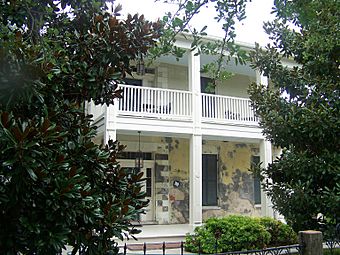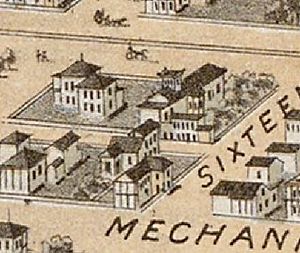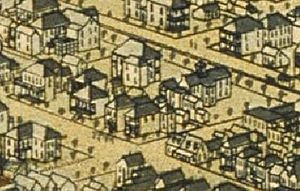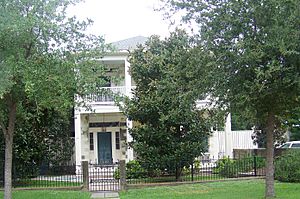George Washington Grover House facts for kids
|
George Washington Grover House
|
|
|
U.S. National Historic Landmark District
Contributing Property |
|
|
U.S. Historic district
Contributing property |
|

Grover House in 2016
|
|
| Location | 1520 Market St., Galveston, Texas |
|---|---|
| Built | 1858-1859 |
| Part of | East End Historic District (ID75001979) |
Quick facts for kids Significant dates |
|
| Designated NHLDCP | May 11, 1976 |
| Designated CP | May 30, 1975 |
The George Washington Grover House is a two-story house in Galveston, Texas. It is located at 1520 Market Street, within the historic East End Historic District. Built in 1859, this house is one of the oldest brick homes in the city.
Contents
Who Was George Washington Grover?
The Grover House is named after its builder, George Washington Grover. He was an early settler in Texas. Grover was born in New York in 1819 and grew up in Ohio. In 1839, his family moved to a farm near Austin, Texas.
A Texas Pioneer
Grover joined other early Texas settlers. On August 11, 1840, he fought for the Republic of Texas. This was during the Battle of Plum Creek against a group led by the Comanche people.
The Santa Fe Expedition
The next year, George W. Grover volunteered again for the Republic of Texas. He joined a group on a trade trip to Santa Fe. At that time, Santa Fe was a Mexican city claimed by Texas.
When the group arrived, Grover was chosen to meet with Mexican officials. But the trip ended badly. A Texan officer surrendered all the men to Mexican authorities. Grover and his friends became prisoners. They had to march all the way to Mexico City. They stayed there until April 1842.
While he was held captive, Grover edited a weekly newspaper. It was called True Blue. He used the pen names "Simon Pure" and "Snooks." This single-page newspaper was written by hand. It reported on the expedition and life in prison.
Returning Home and Traveling More
After being freed, Grover went back to Ohio. He married Hepzy Dana Andrews in May 1844. Sadly, Hepzy died a few months later. Grover stayed in Ohio until 1849. Then, he and a friend, Wright Andrews, went on a gold trip to California.
They sailed from New Orleans. Their ship stopped in Panama and Hawaii. A storm blew their ship off course. When they finally reached San Francisco, they opened a supply store. They also looked for gold. On their way back, they lost their gold in a boat fire. Grover was later in another boat fire. The steamship Louisiana caught fire near Galveston. Forty people died in that accident.
Settling in Galveston
In 1850, Grover decided to move to Galveston. By December 1851, Wright Andrews and his brother Henry joined him. The three started a business. They sold groceries and supplies for ships.
After Henry left in 1852, Grover and Wright Andrews opened their own store. It was in the busy commercial area of the city. In August 1852, Grover married Eliza Ann Crane. Her father was a customs officer in Galveston.
Building the Grover House
In 1858 or 1859, Grover bought land at 1520 Market Street. He wanted to build a house for his growing family. We don't know who designed the house. But we know where some of the building materials came from:
- The bricks were made on Galveston Island. They came from James M. Brown's brickyard. These are the same bricks used for Ashton Villa, another famous house built in 1859.
- The pine wood for the floors came from Pensacola, Florida.
- The marble window sills came from Vermont.
- The granite steps for the western entrance came from New Hampshire.
An Irish worker named Nick White put stucco on the bricks. He scored the stucco to make it look like cut stone. This method was called "rough casting." In 1872, the Galveston Daily News newspaper praised White's work. They said the house "looks to-day almost as good as new."
House Design and Features
The house sits on a large property. It is on the north side of Market Street. The brick house is covered with light brown stucco. This stucco is scored to look like cut stone. The current hipped roof was added in 1943. The first roof had a cupola, a small dome-like structure. You could reach it from the third floor. A hurricane in 1943 damaged the back of the house.
The front of the house has a double gallery. This means it has porches on both floors. These porches were changed or added three times. Today, you can get to the porches from inside the house. The main entrance is on the first floor. It has a fancy doorway with colored glass and decorative columns. The window sills are made of white Vermont marble. They are original to the house.
The Grover House is one of the oldest brick homes still standing in Galveston. Grover's son, Walter, said it might have been the second largest house in Galveston when it was finished. An early description from 1936 tells us about the inside:
- The ceilings are very tall. They have beautiful handmade designs.
- There are handmade stained glass panes in the windows.
- All window and door sills are made of marble.
- The fireplace in the main living room is black marble. The upstairs fireplace is white marble.
- The old kitchen was built over a large underground cistern. This cistern held water for firefighters. Two other cisterns and a cellar are under the house. One cistern is still used today for cool water.
Grover's Life in Galveston
After it was built, the Grover House became a social hub. Walter Grover remembered that "many gay parties were held there." Friends and family often visited from far away.
During the Civil War
Grover's business closed in 1861 when the Civil War began. That year, Grover was elected as a city alderman. He served as Galveston's temporary Mayor during the war. Other city leaders had left the city.
When the Union Army took control of Galveston, Grover met their officers. On January 1, 1863, Union leaders Captain Jonathan Mayhew Wainwright and Lieutenant Commander Edward Lea died during the Battle of Galveston. Grover offered his family's burial plot for them. After the war, some people in Galveston argued about Grover's actions. But he was still respected.
Later Years
By 1870, Grover started his own grocery company. It was at his old business location. An advertisement from 1872 listed his company as selling "family supplies, produce and boat stores." The company closed by 1874.
Grover was also an artist. Two of his paintings are important pictures of Galveston in the mid-1800s. One shows the capture of the U.S.R.C. Harriet Lane during the Battle of Galveston. The other famous painting is "Galveston as Seen from the Main Top of Ship at Central Wharf – October, 1855." This painting is now at the Rosenberg Library.
In his later years, Grover often told stories about his adventures. He talked about the Battle of Plum Creek, the Santa Fe Expedition, the Gold Rush, and the Battle of Galveston. He passed away on December 21, 1901, after a fall. His wife, Eliza, died in 1913. She was one of Galveston's oldest citizens.
Keeping the House Special
The Grover House has been well-cared for over the years. It still looks much like it did when it was built. A big project in the 1990s helped restore many parts of the house. This included fixing the special scored stucco. Some changes made in the mid-1900s were removed. The house was brought back to its original design.
The house was damaged by floods during Hurricane Ike in 2008. An old oak tree in the front yard did not survive. This tree had even lived through the terrible 1900 Galveston Hurricane. All the damage from Hurricane Ike has been fixed. The historic brickwork is still being watched to make sure it stays strong.
The Grover House is listed on the National Register of Historic Places. It is an important part of the East End Historic District.




